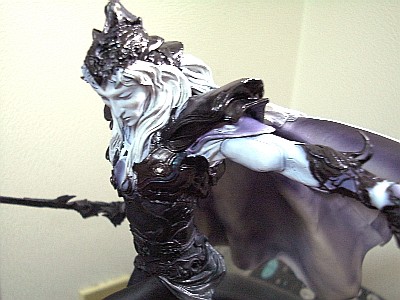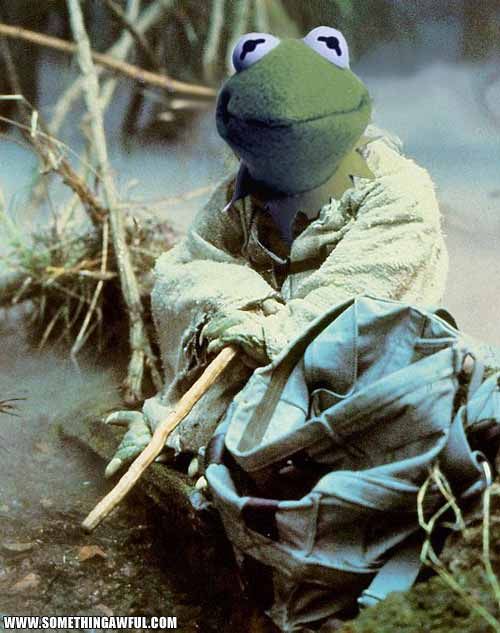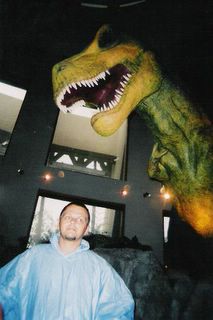Much Ado About Frodo
Hobbit or Human?
from Sploid
Spoilsport scientists have challenged the theory that the tiny skeleton from Indonesia dubbed the "Hobbit" is a new human species. Instead, they say that it may have been a modern human with a brain disorder.
scientists have challenged the theory that the tiny skeleton from Indonesia dubbed the "Hobbit" is a new human species. Instead, they say that it may have been a modern human with a brain disorder.
The creature is believed to have stood just 3 feet tall, and had a brain the size of a chimp. Skeptical scientists say that's too small to give the brain power needed to create the tools found at the site.
"There is a fundamental problem of the tiny brain size combined with the sophisticated stone tools," according to biologist Professor Robert Martin.
Martin and his associates are claiming that the skull is not that of a newly-discovered but extinct species. Instead, they think it is a modern human afflicted with microcephaly, a genetic disorder which causes a smaller than normal brain and head size.
Meanwhile, the Aussie co-discoverer of the Hobbit has dismissed the criticism. Dr Peter Brown says the debunking scientists are making a big mistake in looking at just the one skeleton. As he points out, there are actually skeletal remains of multiple Hobbits from a range of different times, which would seem to rule out the brain disorder theory.
Martin's answer is that the other remains do not include a skull. "It's perfectly plausible that these were pygmy people," he says. "But there's only one skull, and that is human and microcephalic."
However, Brown claims there is other supporting evidence to back his claim which is being ignored, and says the reason why the Hobbit theory is coming under attack is simple - it challenges ingrained beliefs. "Some people see exactly what they want to see, for a variety of reasons," he explains.
The Hobbit has been a controversial discovery because scientists think the remains are from as little as 12,000 years ago, a time when Neanderthals and our other cousins had all died out. Its discoverers believe it may have lived in a miniature 'lost world', inhabited not only by Hobbit-sized people but also dwarf elephants. They also believe they may have been the first Australians.
Cryptozoologists and scientists alike have also suggested that the discovery of the creature may be a boost to the search for Bigfoot. Locals in the area have myths about short, furry people living in the jungle, much like modern America has myths about very tall, furry people.
"You pick a country and there's either large Bigfoot and Yetis, or small leprechauns and Yowies, depending on which part of the world you're in," says Brown. "On Flores there is a mythical human-like animal called Ebu Gogo, known for small body size, inarticulate speech and an unusual bipedal gait."
Even the editor of the prestigious journal Nature, Henry Gee agrees. "The discovery that Homo floresiensis survived until so very recently, in geological terms, makes it more likely that stories of other mythical, human-like creatures such as Yetis are founded on grains of truth," he says. "Now, cryptozoology, the study of such fabulous creatures, can come in from the cold."
from Sploid
Spoilsport
 scientists have challenged the theory that the tiny skeleton from Indonesia dubbed the "Hobbit" is a new human species. Instead, they say that it may have been a modern human with a brain disorder.
scientists have challenged the theory that the tiny skeleton from Indonesia dubbed the "Hobbit" is a new human species. Instead, they say that it may have been a modern human with a brain disorder.The creature is believed to have stood just 3 feet tall, and had a brain the size of a chimp. Skeptical scientists say that's too small to give the brain power needed to create the tools found at the site.
"There is a fundamental problem of the tiny brain size combined with the sophisticated stone tools," according to biologist Professor Robert Martin.
Martin and his associates are claiming that the skull is not that of a newly-discovered but extinct species. Instead, they think it is a modern human afflicted with microcephaly, a genetic disorder which causes a smaller than normal brain and head size.
Meanwhile, the Aussie co-discoverer of the Hobbit has dismissed the criticism. Dr Peter Brown says the debunking scientists are making a big mistake in looking at just the one skeleton. As he points out, there are actually skeletal remains of multiple Hobbits from a range of different times, which would seem to rule out the brain disorder theory.
Martin's answer is that the other remains do not include a skull. "It's perfectly plausible that these were pygmy people," he says. "But there's only one skull, and that is human and microcephalic."
However, Brown claims there is other supporting evidence to back his claim which is being ignored, and says the reason why the Hobbit theory is coming under attack is simple - it challenges ingrained beliefs. "Some people see exactly what they want to see, for a variety of reasons," he explains.
The Hobbit has been a controversial discovery because scientists think the remains are from as little as 12,000 years ago, a time when Neanderthals and our other cousins had all died out. Its discoverers believe it may have lived in a miniature 'lost world', inhabited not only by Hobbit-sized people but also dwarf elephants. They also believe they may have been the first Australians.
Cryptozoologists and scientists alike have also suggested that the discovery of the creature may be a boost to the search for Bigfoot. Locals in the area have myths about short, furry people living in the jungle, much like modern America has myths about very tall, furry people.
"You pick a country and there's either large Bigfoot and Yetis, or small leprechauns and Yowies, depending on which part of the world you're in," says Brown. "On Flores there is a mythical human-like animal called Ebu Gogo, known for small body size, inarticulate speech and an unusual bipedal gait."
Even the editor of the prestigious journal Nature, Henry Gee agrees. "The discovery that Homo floresiensis survived until so very recently, in geological terms, makes it more likely that stories of other mythical, human-like creatures such as Yetis are founded on grains of truth," he says. "Now, cryptozoology, the study of such fabulous creatures, can come in from the cold."







 what the Great Conjunction is. 'What's the Great Conjunction?'
what the Great Conjunction is. 'What's the Great Conjunction?' 




 A Is for Androids
A Is for Androids B Is for Boba
B Is for Boba C Is for Calvin
C Is for Calvin D Is for Dragons
D Is for Dragons E Is for Elric
E Is for Elric F Is for Futures
F Is for Futures G Is for Genie
G Is for Genie H Is for Hobbits
H Is for Hobbits I Is for Iceman
I Is for Iceman J Is for Jedi
J Is for Jedi K Is for Kraken
K Is for Kraken





































































0 Comments:
Post a Comment
<< Home